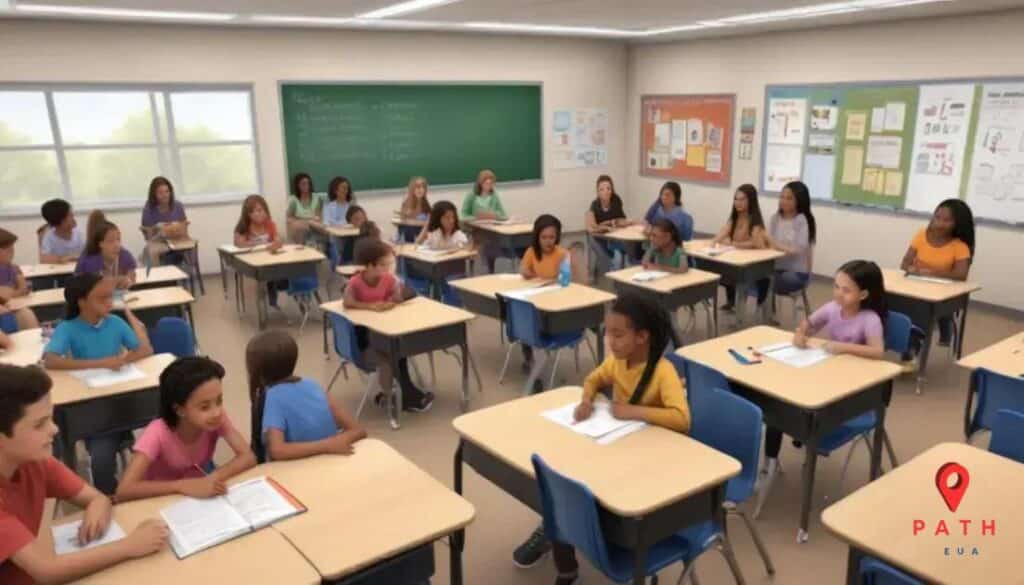Future of DEI initiatives in education: What’s next?

Anúncios
The future of DEI initiatives in education focuses on leveraging technology, fostering cultural competence, and building community partnerships to create inclusive environments that support all students effectively.
Future of DEI initiatives in education is a pressing topic that impacts students and teachers alike. Have you ever wondered how these changes will shape our learning environments moving forward? Let’s dive into this evolving conversation.
| Topic | Details | Highlights |
|---|---|---|
| What is DEI | Diversity, Equity, and Inclusion in education | Supports all students |
| Technology’s Role | Assistive tools, data platforms, teacher training | Boosts access and insight |
| Implementation Challenges | Resistance, lack of resources, miscommunication | Needs ongoing support |
| Success Examples | Mentorships, diverse curricula, family outreach | Improves engagement |
| Future Trends | Cultural training, tech integration, SEL focus | Equity-driven innovation |
Anúncios
Understanding DEI initiatives in education
Understanding DEI initiatives in education is crucial for creating inclusive learning environments. These initiatives focus on diversity, equity, and inclusion, aiming to ensure that all students feel valued and supported.
By recognizing the variety of backgrounds and experiences among students, educators can implement effective programs that enhance learning for everyone.
Anúncios
Key Components of DEI Initiatives
DEI initiatives typically include plans to:
- Promote diverse hiring practices among staff.
- Develop curricula that reflect various cultures and perspectives.
- Implement training programs that foster inclusivity within schools.
According to the U.S. Department of Education, effective DEI strategies are integral to improving student outcomes. When students see themselves represented in their education, it fosters a sense of belonging and community.
Additionally, creating an equitable environment means providing all students with the resources they need to succeed, regardless of their starting point. This requires ongoing assessment and adjustment of educational practices.
The role of technology in advancing DEI
The role of technology in advancing DEI initiatives is significant in today’s educational landscape. Through innovative tools, schools can enhance inclusivity and accessibility for all students.
Technology enables educators to create diverse learning environments that cater to various needs, promoting a culture of equity and respect.
Technological Tools Supporting DEI
Several technological advancements support DEI, such as:
- Assistive technologies that help students with disabilities participate fully in classes.
- Online platforms that facilitate collaboration among diverse student groups.
- Data analytics tools that allow schools to assess and improve their DEI efforts.
For instance, using data-driven insights, educators can identify gaps in representation and tailor support to underserved populations. This ensures that every student’s voice is heard.
Furthermore, technology helps in training teachers on cultural competence, enabling them to better understand and address the needs of their diverse students. It also provides access to a wider range of perspectives and resources.
Challenges faced in implementing DEI programs

Implementing DEI programs in educational settings can be challenging. Despite the good intentions behind these initiatives, various obstacles may arise during execution.
Many educators and schools encounter issues that can hinder their efforts to foster a truly inclusive environment.
Common Challenges in DEI Implementation
Some common challenges faced include:
- Lack of understanding about what DEI truly means among staff and students.
- Resistance to change from individuals who prefer traditional educational methods.
- Insufficient resources allocated to training and program development.
In many cases, miscommunication can create barriers. It’s essential to ensure everyone is on the same page regarding the goals of DEI programs.
Moreover, without proper training, staff may struggle to effectively engage with diverse students, potentially leaving some at a disadvantage.
To address these challenges, ongoing education and open dialogue among all stakeholders is crucial.
According to the U.S. Department of Education, successful DEI initiatives require commitment and active participation from the entire school community.
Success stories of effective DEI strategies
Success stories of effective DEI strategies showcase how schools can foster a more inclusive environment. These examples serve as inspiration and provide practical insights into what works.
Many educational institutions have implemented DEI initiatives that resulted in positive changes, benefiting both students and staff.
Examples of Successful DEI Strategies
Some notable success stories include:
- Schools that have created mentorship programs pairing diverse students with role models.
- Implementation of curriculum changes to include diverse authors, histories, and perspectives.
- Utilization of data analytics to monitor student performance and ensure equitable access to resources.
For instance, a district in California established a comprehensive cultural competency training program, improving relationships between students and teachers. According to research from the U.S. Department of Education, schools that prioritize DEI show enhanced student engagement and achievement.
Additionally, an initiative in New York City introduced multilingual support, helping non-English-speaking families feel included and informed. This practice fostered community involvement and improved student outcomes.
Future trends in educational DEI initiatives
The future of educational DEI initiatives is bright, with numerous trends shaping inclusive practices in schools. As society evolves, so do the strategies that promote diversity, equity, and inclusion among students.
By embracing innovative solutions, educators can create a more supportive environment for all learners.
Key Trends in DEI Initiatives
Some emerging trends to watch include:
- Increased use of technology to enhance accessibility and learning experiences for diverse learners.
- Focus on social-emotional learning to build empathy and understanding among students.
- Partnerships with community organizations to promote outreach and support for underrepresented groups.
Schools are beginning to recognize the importance of incorporating culturally relevant pedagogy into their curricula. This approach not only reflects the diverse backgrounds of students but also enhances engagement and retention.
Furthermore, training and development programs for teachers are prioritizing cultural competence and equitable teaching practices. Research from the U.S. Department of Education emphasizes that these strategies can lead to improved student performance and well-being.
Ultimately, as DEI initiatives continue to evolve, ongoing assessments and adaptations will be crucial in meeting the needs of all students.
In summary: The future of DEI in education
The progress in DEI initiatives in education is vital for creating inclusive and supportive learning environments. By understanding the challenges and embracing effective strategies, schools can truly make a difference.
As we look to the future, it is clear that technology, community partnerships, and a focus on cultural competence will shape the way we educate.
It’s essential to continually assess and adapt these initiatives to meet the needs of all students. With commitment and creativity, we can ensure that every student has the opportunity to succeed.
Let’s continue to advocate for DEI, as it benefits not just individual students, but also our society as a whole.
FAQ – Frequently Asked Questions about DEI in Education
What are DEI initiatives in education?
DEI initiatives in education focus on promoting diversity, equity, and inclusion among students and staff to create a supportive learning environment.
How can technology help improve DEI efforts?
Technology can enhance DEI efforts by providing tools for accessibility, facilitating communication, and allowing for data analysis to monitor progress.
What are some challenges schools face in implementing DEI programs?
Common challenges include resistance to change, lack of resources, and insufficient understanding among staff and students about DEI principles.
Why are success stories important for DEI initiatives?
Success stories showcase effective strategies and inspire other schools to adopt similar practices, demonstrating that meaningful change is possible.